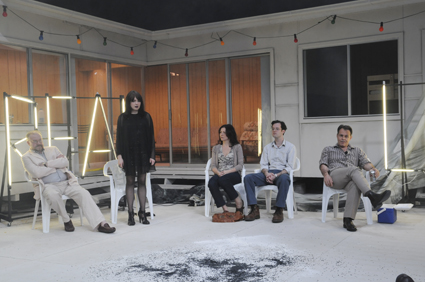 |
The Seagull, Belvoir photo Heidrun Löhr |
belvoir: the seagull
The plays of Anton Chekhov are melancholy writ large: sad, wise reflections on constrained lives, dreams unrealised, love lost and empathy thwarted by deeply engrained defense mechanisms. Benedict Andrews’ version (from a literal translation by Karen Vickery) of Anton Chekhov’s The Seagull gently transposes the play’s setting from a late 19th century Russian country estate to a fibro holiday shack on an Australian rural property in our own 21st century. Somewhat pared back and brush-stroked with touches of Australian English and a smattering of contemporary references, production and text are faithful to the spirit and much of the significant detail of the original play. For an Andrews’ production this is an unusually but aptly relaxed affair, taking the requisite time to establish mood, the informal comings and goings, incidental encounters and the emotional flash points so common to family holidays.
Designer Ralph Myers’ L-shaped cream painted shack is an immaculately neat imitation of the real thing, with an open space before it where much of the play unfolds. Although appropriately furnished inside, the house outside is not aged—not touched up with rust or rot or fringed with weeds or shaded by trees. The playing space is equally stark. But as part abstract and calculatedly liminal as this design is, Damien Cooper’s lighting makes the most of its blankness to glare or haze in intense summer light and glow warmly at night. The outdoorness is emphatic. Of course, it’s where Konstantin’s experimental play is staged—with Nina reciting from inside a glass box (perhaps Andrews is mildly parodying his own productions of Eldorado and Who’s Afraid of Virginia Woolf? or Belvoir’s The Wild Duck). The box, framed by the words REAL LIFE spelled out in neon, subsequently becomes a handy metaphorical device, but as an instance of 21st century avant-gardism the transposition from the 19th isn’t easily made.
In this space a strong cast realises The Seagull with an easy sense of ensemble. Judy Davis as the ageing actress Irina is elegantly volatile (no wonder she takes exception to her son Konstantin’s play; not only is it “pseudo avant-garde”, it embraces mortality) and wickedly comic at moments; David Wenham’s deadpan Trigorin is scarily manipulative; Bille Brown’s cheerily mellow Dorn, the doctor, has sympathy for Konstantin but not enough insight to save him; John Gaden’s frail Sorin, the owner of the property, is a self-contained comedy of regret and Emily Barclay’s Masha is a blunt, joint-smoking Goth. As Konstantin, Dylan Young faces the play’s largest challenge, one he almost meets—to convey sufficient emotion and complexity in the course of the play to warrant our belief in his suicidal destiny, not least when it’s Nina who gets, as it were, the last word centrestage, desperately struggling to express her fate: “One day, a man comes along, sees her, and having nothing better to do, destroys her. An idea. For a story. No, that’s not it. What was I saying?” Maeve Dermody vibrates with Nina’s continuing passion for Trigorin but knows she must leave, regretting lost innocence, reciting the very words she had spoken in Konstantin’s play, about a world dying, and then rushing away. The last vestige of Konstantin’s fantasy of a life with Nina evaporates, his belief in himself as a writer already shattered. The melancholic aura of incomplete lives (even the successful Trigorin describes writing as obsessive-compulsive), of life-sustaining delusions and semi-conscious cruelties is ruptured by suicide—a step too far, into either pathos or tragedy.
version 1.0: the table of knowledge
You wouldn’t expect anything melancholic of version 1.0’s The Table of Knowledge. It’s a scathing, straight from the horse’s mouth account of astonishing corruption within the Wollongong City Council and the local business community (for details see the interview with David Williams). It’s riotously funny in its judicious selection of verbatim material, in its deployment of a mock injunction to shut down the show and having blocks of the audience play out the dodgy council property development approval process. But as the second act progresses the mood shifts into darker emotional territory when the woman at the centre of the scandal, Beth Morgan, realises at the inquiry that she has been betrayed by her partner in crime—this at the very time she has found the whole sexual and financial adventure beyond her capacity to manage. Her isolation is profound. But as with the whole production, conventional acting is not version 1.0’s tool. Here Kim Vercoe as Morgan brings just enough emotional intensity to the role to suggest not tragedy but a degree of pathos, drawing from us empathy for someone caught in their own machinations. Equally, version 1.0 are careful not to make the sexual favours, so focused on by the mass media, the centre of their investigation.
Characterisation is otherwise broadly brush-stroked, largely played straight to the audience and with the performers adopting multiple roles against screens that constantly, even relentlessly reveal the unfolding visions of developers’ dreams—architectural fantasies of an anonymous high rise regional city. Late in the second act as the scheming collapses, the waves that break on Wollongong’s shores turn suggestively pink as if bloody. The Table of Knowledge is richly inventive, a feast of appalling information, revelations about criminal cunning and stupidity in equal parts (two men pretending to be ICAC investigators blackmailed the “table of knowledge” conspirators). If it wasn’t so funny it would be depressing, but by the time we watched on as Beth Morgan and her former lover Frank Vellar stood alone and apart and one time Council General Manager Rod Oxley lectured us about the impediments of regulation to innovation, we knew we would leave the theatre feeling more sad than angry—a degree more helpless, a little more worldly.
Version 1.0 made great comic play on the uniqueness of this story of corruption to Wollongong while presenting a litany of the many other councils that have likewise fallen across the country. This is a production that should be seen widely as councils play an increasing role in our lives—from fleecing us to building our arts centres. The fact that Wollongong’s citizens turned out in droves to see The Table of Knowledge, extending the season, speaks both of the work’s relevance and the power of an idiosyncratic theatricality, largely new to this audience, that they wholeheartedly embraced.
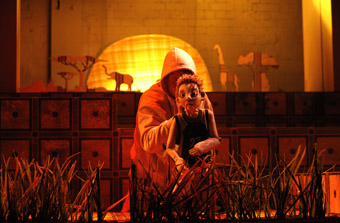 |
Africa, My Darling Patricia photo Jeff Busby |
stc next stage: africa
In My Darling Patricia’s Africa, three children—two sisters and a neglected boy from the neighbourhood—immerse themselves in an African fantasy world, identifying themselves with particular animals and even setting out for the airport to make the journey to a land “where chips grow on trees” and “animals talk.” As in the events in Germany that inspired this work, the children are returned to their home by the authorities. But My Darling Patricia takes the story further, into the dark territory of parental neglect and sexual abuse.
The power of Africa comes from its vivid and detailed realisation of the children’s fantasy world, made especially potent by its use, principally, of puppetry in the Bunraku tradition, intricately generating expression (including the mouthing of words) and movement—not least with characterful ways of walking and dancing.
The children’s room is a cleverly designed tiered set with spaces between each level for the puppeteers to move freely. The topmost level reveals only the legs of adults (actors, not puppets) in their world apart, dancing, drinking, fighting—it’s comic at first, threatening later. Eventually the adults enter the children’s room: a devious male bearing gifts and a less than fully caring mother who transforms into a snarling lion when the man transgresses. In the end, the mother must move her family, leaving the boy behind. For a moment it appears that he will be able to sustain the children’s Africa on his own—long leaves of grass sprout from the floor, but then sink and disappear, the collective fantasy lost. It’s a deeply sad final moment in a now otherwise bare room—the sheer volume and density of toys and enacted fantasies gone forever. The puppeteering, design, music (making fine use of toy piano and accordion), props and projections are seamlessly integrated in a production that is endlessly inventive and emotionally demanding, if often very funny. The ending resonates with a line uttered by one of the children after the police have brought them home: “People like us don’t go to Africa.”
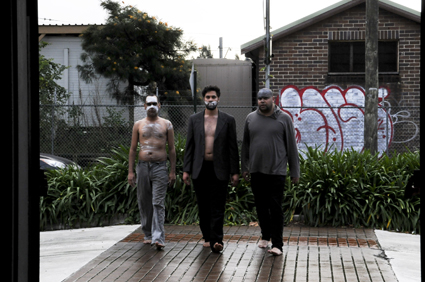 |
Sonny Dallas Law, Bjorn Stewart, Colin Kinchella, Bully Beef Stew, PACT photo Heidrun Löhr |
pact: bully beef stew
At the commencement of Bully Beef Stew, a performance commissioned by PACT Centre for Emerging Artists, the three Indigenous male performers announce that this will “not be a variety show” while everything they do suggests it well might be. It’s certainly funny. However as it progresses, Bully Beef Stew becomes an engaging and moving meditation on reconciliation—between fathers, who have passed away, and sons. Director Andrea James and performers Sonny Dallas Law, Colin Kinchela and Bjorn Stewart embrace a variety of simple means from solo testaments and song and dance to the inventive deployment of a toy train set (the adult becomes child again on a tiny chair), packing tape, a boxing glove, sound design (a speeding car roars like a jet engine) and projections. What emerges from this playfulness is melancholic: these young men miss their fathers, wondering what they’ve inherited from them, what might need to be forgiven, and what it means to be an Indigenous man: “can I be beautiful”...”am I spiritual?” They are not sentimental, some of the lines are tough: “You’ll never be my equal, just my father.” The world they have inherited and might duplicate is suffused with alcohol, abuse, neglect and deaths in custody. As one of them asks about his father, “Is he me?” But ultimately Bully Beef Stew is about acceptance, forgiveness and reconciliation, the mood sombre and physically shared with the audience as the performers gently reach out to touch our hands. This production reveals the considerable promise of the performers and the potential of the work.
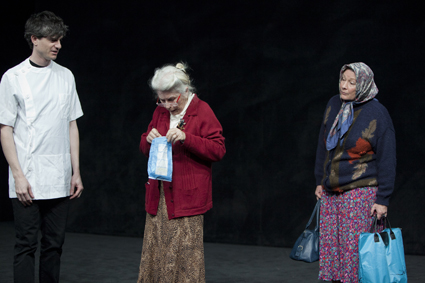 |
Stefan Gregory, Robyn Nevin, Kris McQuade, Neighourhood Watch, Belvoir photo Brett Boardman |
belvoir: neighbourhood watch
Lally Katz’s Neighbourhood Watch is a whimsical fable with melancholic and even darker undercurrents; with a subdued melodramatic structure; and characters living on if almost over the edge of neurosis. The setting is Australian suburbia, the design two vast, overlapping grey walls cradling a performance space that becomes the everyday only by dint of costumes, occasional props and the opening ritual of the weekly placement of rubbish bins on imaginary footpaths where isolated neighbours are otherwise unlikely to meet. It’s a liminal space where past and present, reality and fantasy can likewise overlap at a word or the turn of a revolve.
Ana (Robyn Nevin), one of two central characters is a Hungarian immigrant—child of an uncaring father who dies young; near teenage victim of a serial killer; a nurse during World War II; prisoner in post-war detention camps for 14 years across Europe; and the literally imprisoned wife of an Italian in Australia. On the upside, she travels into Russia on behalf of a legless soldier she met in hospital and her marriage, in Australia, to a Serbian has been a happy one—until his death from cancer, from which Ana herself is also dying. This challenging life is revealed piece by piece across the duration of the play, building a complex character, exquisitely realised by Robyn Nevin, who oscillates between paranoia and brusque friendliness, often comically phrased in her broken English. She now lives alone with Bella, an aggressive Alsatian and constantly rejects the friendly approaches of an elderly Serbian woman, Milova (Kris McQuade), whom she regards as a spy, and treats her doctor appallingly as a murderer who seduced her husband: “You deliver first the news of my husband’s death and now of Ana’s. You kill us both.” Despite her paranoid disposition she chats amiably with a neighbour, Christina (Heather Mitchell), another cancer survivor, the local pharmacist and especially Catherine (Megan Holloway), a would-be actress in her mid 20s lamenting the loss of a lover, Martin (Ian Meadows).
The play’s momentum is predicated on the developing relationship between the older and the younger woman. Ana’s belief in her own sixth sense, her own “ultrasound,” is what she would like to instil in Catherine—a capacity to be distrustful of the world, while at the same time encouraging her, very conventionally, to find a relationship, or open up about the one she might have. She makes little headway. Ana, however, gives much to Catherine, a willing fantasist who slips easily into Ana’s role as the Hungarian woman’s past is played out—the revolve turns and the characters walk back in time, even to comic effect as Ana magically has Catherine and those she encounters speak in her odd English. But it can’t be said that Ana reciprocally draws Catherine out; this is a problem. Late in the play Ana learns that Martin is dead, a suicide, a ghost; in the meantime we’ve witnessed Catherine’s encounters with a returned Martin as real; she is more of a fantasist than we thought. Catherine’s closed life is echoed by that of her housemate, Ken, a diabetic in his 30s and would be filmmaker whose friends are online game-players. These two thinly support each other emotionally, although that falls part, each knowing the other can’t face reality.
While Ana is an idiosyncratic force to be reckoned with, Catherine is a simpler figure whom I wished had more character (despite Megan Holloway’s best efforts), brittleness perhaps, flights of fancy about her acting career, moments of giving way just a little to Ana’s probings. In the end Ana, Milova and Catherine come together; it’s a redemptive moment of a kind for Ana, conceding to see the film Mamma Mia with the two women and to have coffee at Milova’s home. In that very moment she collapses and presumably soon dies. Catherine and Ken are re-united, Ken has found a producer for his film, Catherine might have a role in it and they share the house with Ana’s dog. It’s an all too easeful crowd-pleasing ending, difficult to equate with the intensifying melancholy and the revelations of the play’s progress. But Katz and Nevin nonetheless create a powerful, complex stage force in their realisation of Ana.
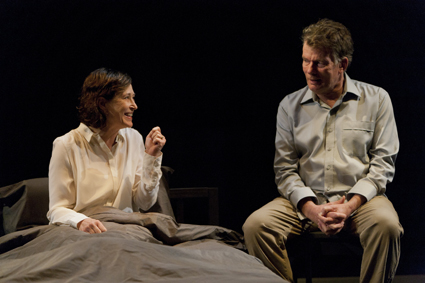 |
Linda Cropper, Russell Kiefel, No More Shall We Part, Griffin courtesy Griffin Theatre |
griffin: and no more shall we part
A potential suicide in Tom Holloway’s And No More Shall We Part comes in the form of euthanasia, as a middle-aged wife, Pam, decides to end her life rather than endure the agonies that will come with her dying months. In her final hours as she waits in bed for the drugs to take effect, she and her husband converse with inevitable awkwardness, intimacy and moments of recollection. Scenes from previous weeks are interpolated into this grim night-watch, revealing Pam’s determination to die at a time of her own choosing rather than surrender to her husband’s accusations of selfishness or his fanciful suggestion of a trip to Switzerland for legal euthanasia—or, he hopes, advice there to abandon it. Don is progressively revealed to be something of a fantasist, not fully comprehending his wife’s need, clinging to a togetherness that cannot last. The play offers a gruelling experience not least in its disturbing, indeterminate conclusion.
Russell Kiefel as Don and Linda Cropper as Pam deliver subtle, sympathetic performances, passionate in the flashbacks, tentative and tender in the present, although Pam does not spare Tom her criticisms of his character. The sombre mood is occasionally if blackly alleviated, for example Don wondering if he goes to the toilet he’ll miss the moment of Pam’s dying. Amidst all the moral complexities, the overriding mood is one of sadness, not simply with regard to an impending death but because it’s the significant differences as much as the similarities between these two fairly ordinary people make them the couple they are. And sadder, Pam reveals herself to be something other than ordinary in her clarity of purpose and preparation without ever rejecting Don’s love. Sadder still is the alarming ending when Pam’s determination is defeated, but for how long? The mood however is somewhat undercut by the playwright’s insistent use of short lines of dialogue that overplay the tentativeness of the situation, adding too heavy an air of artifice. Holloway’s idiosyncratic stage language is usually much more effective; here it is in constant danger of locking into fixed rhythms. The set design is also somewhat awkward, alternating between bedroom and, behind it, dining room, making me wonder about the logic of the play’s flashback structure. But the calibre of the performances and the topicality of a demanding subject made for sustained if melancholy reflection long afterwards.
performance space: the harry harlow project
The Harry Harlow Project, a show from Melbourne written and performed by James Saunders and directed by Brian Lipson is a considerable challenge to one’s sense of empathy. The American psychologist (1905-1981) set up an experiment placing baby rhesus monkeys with surrogate ‘mothers,’ one a piece of terry cloth to show that the need for touch was critical and, the other, a wire structure that provided food—even then if the cloth was available it was preferred. But Harlow went further, torturing baby chimpanzees in his “pit of despair” for up to 24 months, driving them into psychosis by isolating them, depriving them of real maternal affection. Radically, he was out to prove that ‘love’ should be in the lexicon of mainstream psychology and that touch and nurture were crucial to the emotional and cognitive development of children. It’s almost impossible to believe that this was not a cultural given in the first half of the 20th century, but it wasn’t—intimacy was seen as spoiling the independent growth of the child.
The Harry Harlow Project reveals a man in decline, presumably at the end of his career, in a pit of despair of his own. The play creates a purgatory for Harlow, punishing him for his sins—his indifference to animals, his multiple marriages, his unscientific language (a forced mating device he named a “rape rack,” the wire mother an “iron maiden”). He feels nothing, loves nothing, he disconnects his phone, the shadow of a cage falling across his bed. Earlier, he lectures us, appears on TV, embraces a huge toy monkey and then crushes it. He inhabits a large white room. On the walls are dimly projected images of his monkey victims, but he declares, “I have no cloth...I am not a monkey.” His focus has been on what he can learn about human children via monkey behaviour, a desire “to save 100 million mistreated children, not monkeys.” While Harlow apparently changed attitudes to child raising and is much lauded for it, the means were appalling. That other scientists enacted similar torments on children makes Harlow no less a villain. Ironically his experiments are regarded as a trigger for the evolution of the animal liberation movement.
If you didn’t know who Harlow was then finding your way into The Harry Harlow Project could have been difficult: it’s a work that commences rather surreally, requiring considerable attentiveness as Saunders’ American-accented rendering of Harlow’s tirades and panics frequently hit the one note. But by the end the picture is clearer if complex. Are we supposed to pity this man in his living hell?—it’s a hard call. You leave the theatre curious, as if having watched a quite unfamiliar animal for the first time, but above all saddened at the inflicting of suffering on one species to reduce the pain of another.
Belvoir: The Seagull, writer Anton Chekhov, a version by director Benedict Andrews, performers Emily Barclay, Bille Brown, Gareth Davies, Judy Davis, Maeve Dermody, Mel Dyer, John Gaden, Anita Hegh, Terry Serio, Thomas Unger, David Wenham, Dylan Young, designer Ralph Myers, costumes Dale Ferguson, lighting Damien Cooper, composer, sound designer Stefan Gregory, Belvoir Upstairs, June 8-17; version 1.0 & Merrigong Theatre, The Table of Knowledge, devisor performers Arky Michael, Jane Phegan, Yana Taylor, Kim Vercoe, David Williams, deviser Alan Flower, video design, deviser Sean Bacon, sound design Gail Priest, lighting Frank Mainoo; Illawara Performing Arts Centre, Aug 30-Sept 20; Sydney Theatre Company, Next Stage: My Darling Patricia, Africa, concept Sam Routledge, director, writer Halcyon Macleod, performers Anthony Ahern, Michelle Robin Anderson, Clare Britton, Jodie Le Visconte, design Clare Britton, Bridget Dolan, composer, sound designer Declan Kelly, puppets Bryony Anderson, lighting Lucy Birkinshaw, STC, Wharf 2, Sept 1-17; Bully Beef Stew, co-creator director Andrea James, co-creators, performers Sonny Dallas Law, Colin Kinchela, Bjorn Stewart, choreographer Kirk Page, media artist Jacqui Mills, sound design Melissa Hunt, lighting Clytie Smith; PACT Theatre, June 29-July 9; Griffin Theatre Company: And No More Shall We Part, writer Tom Holloway, director Sam Strong, performers Linda Cropper, Russell Kiefel, designer Victoria Lamb, lighting Verity Hampson, sound design, composer Kelly Ryall, Griffin, Aug 4-Sept 3; Belvoir, Neighbourhood Watch, writer Lally Katz, director Simon Stone, performers Charlie Garber, Stefan Gregory, Megan Holloway, Kris McQuade, Ian Meadows, Heather Mitchell, Robyn Nevin, design Dale Ferguson, lighting Damien Cooper, composer, sound designer Stafan Gregory; Belvoir Upstairs, July 23-Aug 28; Performance Space & Mobile States: The Harry Harlow Project, writer-performer James Saunders, direction, design Brian Lipson, video artist Martyn Coutts; CarriageWorks, Sydney, Sept 7-10
RealTime issue #105 Oct-Nov 2011 pg. 34-35
© Keith Gallasch; for permission to reproduce apply to [email protected]








 back
back